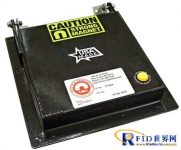
Application of RFID Technology in Magnetic Separator Management
[ad_1]
Earlier this year, IMI, a manufacturer of magnetic separators, helped inspectors store product inspection data by pasting passive ultra-high frequency (UHF) RFID tags that conform to the EPC Gen 2 standard to the magnetic separators produced, so that customers can understand the detailed quality information. The user reads the information of the product through the hand-held reader. The label provider in the solution is InfoChip Systems.
Michigan-based IMI Corporation is a manufacturer of magnetic products. Magnetic separators are mainly used in batch processing workshops, especially food processing workshops. The magnetic separators are placed next to the processed food to separate the small metal fragments lost by the machine during the processing.

As shown in the figure, the yellow label on the magnetic separator is the place where the UHF RFID label is attached
According to the manufacturer, magnetic separators are subject to periodic test checks to verify that they are working properly. The inspection work can be inspected by the user’s workers, or the manufacturer is responsible. In fact, IMI company provides users with free testing services.
In recent years, with the improvement of food safety requirements, the number of magnetic separators used has increased year by year. With more than 30 magnetic separators placed in the workshop, traditional management methods alone have become difficult. Food processing has high hygienic requirements for the environment. Most of the printing codes are easy to fail in high temperature environments. RFID tags can avoid the above problems, and have high detection efficiency, which is convenient for data writing and reading.
Currently used RFID tags are provided by InfoChip, with a diameter of 0.75 inches and are designed for special application environments. Each newly produced machine is affixed with an RFID tag, and for the early production machines, if the user has a demand, the tag can also be obtained for free. However, users need to purchase corresponding label readers and software systems. In this solution, a Bluetooth reader is used to read UHF RFID data and send it to other receiving devices, such as tablets. InfoChip software is installed on the company’s back-end server, mainly to store RFID codes and related data.
The code of the label is sent to the user’s ERP system or a cloud-based backend server, where it is associated with other machine-related data (eg, production time, location, time of labeling, test records).
The nfoChip software stores the maintenance and inspection records of the machine. When the inspection period is exceeded, the system will send a warning to the company’s maintenance and inspection department in the form of email, or send it directly to the handheld tablet.
The application of RFID technology enhances the competitiveness of IMI company and improves the maintenance efficiency of machines; for users, RFID technology is an accessory value.
[ad_2]


